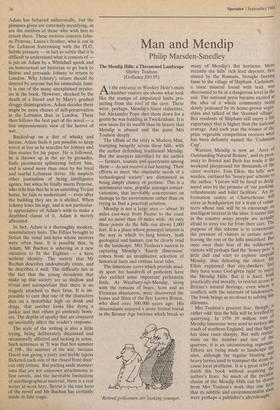Man and Mendip
Philip Marsden-Smedley
The Mendip Hills: a Threatened Landscape Shirley Toulson (Gollancz £10.95)
At the entrance to Wookey Hole's main chamber visitors are shown what look like the stumps of amputated limbs pro- jecting from the roof of the cave. These were, perhaps, Mendip's finest stalactites, but Alexander Pope shot them down for a grotto he was building in Twickenham. It is now more for its wealth than its beauty that Mendip is abused and this pains Mrs Toulson deeply.
The villain of the story is Modern Man, tramping hungrily across these hills, with the author defending traditional Mendip. But the usurpers identified by the author — farmers, tourists and quarrymen among them — do not receive a fair hearing. Their efforts to meet 'the insatiable needs of a technological society' are dismisssed as being simply clumsy or profane. This is a sentimental view, popular amongst conser- vationists, that inevitably concentrates on damage to the environment rather than on trying to find a practical solution.
Mendip is not a large area — about 30 miles east-west from Frome to the coast and no more than 10 miles wide. At only three points do the hills rise above 1,000 feet. It is a place whose principal interest is the way in which its long history, both geological and human, can be clearly read in the landscape. Mrs Toulson's success in capturing Mendip's 'fourth dimension' comes from an imaginative selection of historical facts and curious local tales.
The limestone caves which provide mud- dy sport for hundreds of potholers have also yielded some important prehistoric finds. At Westbury-sub-Mendip, along with the remains of bears, lions and an Etruscan rhinoceros, were discovered the bones and flints of the first known Briton, who died over 300,000 years ago. His descendants enjoyed a more formal burial in the Bronze Age barrows which break so 'Retired policemen are looking younger.' many of Mendip's flat horizons. More recently the hills' rich lead deposits, first mined by the Romans, brought fleeting fame to the village of Shipham. Cadmium, a toxic mineral found with lead, was discovered to be at a dangerous level in the soil. The national press became excited at the idea of a whole community being slowly poisoned by its home-grown veget- ables and talked of the 'doomed village'. But residents of Shipham still enjoy a life expectancy that is higher than the national average. And each year the winner of the prize vegetable competition receives what has been defiantly named the 'Cadmium Cup'. Western Mendip is now an 'Area of Outstanding Natural Beauty', and its prox- imity to Bristol and Bath has made it the weekend playground for thousands of the cities' workers. Tom Elkin, the hills' new warden, outlined his 'honey-pot' scheme t° the author. Visitors will be lured to desig- nated sites by the promise of 'car parking, refreshments and toilet facilities'. An irl", formation centre at Charterhouse serve as headquarters for a team of volufl" teers whose task will be to encourage an intelligent interest in the sites: it seems that in the country many people are actuallY afraid to stray too far from their cars. The purpose of this scheme is to concentrate the pressure of visitors in certain areas, leaving the rest of the hills unscathed. But once over their fear of the wilderness, visitors will perhaps find the 'honey pots' a little dull and start to explore unsPuilt Mendip, thus defeating the object. Mr, Elkin explained that city-dwellers lee' they have some God-given right' to en.loY the Mendip Hills. But it is hard, both practically and morally, to restrict access V/ Britain's natural heritage, even where it conflicts with the interests of landowners. The book brings us no closer to solving this dilemma. Mrs Toulson's greatest fear, though, is rather odd: that the hills will be levelled by quarrying. In 1976 10 million tons 01 Mendip limestone were used to surface the roads of southern England, and that figure has since risen sharply. But with restric- tions on the number and size of the quarries, it is an unconvincing argument'
the Efforts are being made to landscape ,
sites, although the regular blasting heavy lorries used to transport the stone _ cause local problems. It is a great relief we finish this book without acquiring t.11, author's fears. So much of the peculla` charm of the Mendip Hills can be draw,n from Mrs Toulson's work that one fee% that its subtitle and environmentalist slat' were perhaps a publisher's afterthought.










































 Previous page
Previous page